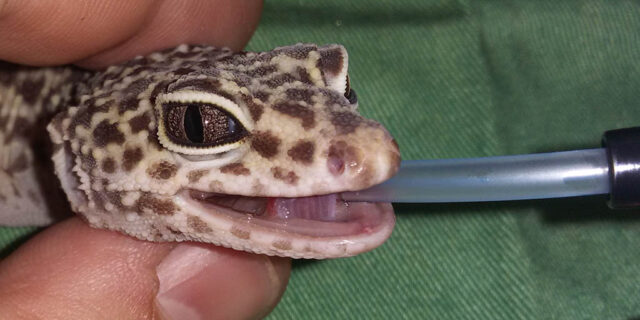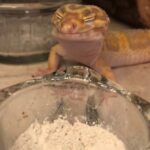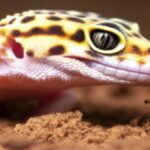This article is tagged to be informative to veterinarians too. The information is not a substitute for advice from your veterinarian.
Nutrition support in Leopard geckos is often required in the case of anorexia or inability to eat. It is often used as part of a medical treatment plan until such a time food consumption has returned to normal.
Table of Contents
Introduction
Refusal to eat and weight loss are often seen in Leopard geckos due to ill health and other medical conditions. Correct nutrition during, and after, diagnostics and treatment can significantly shorten recovery times and even be life-saving. It will help to gain the weight that was lost, allow growth and to maintain hydration. Nutritional support is often instigated by the attending veterinarian, but can continue long after the patient has been discharged. Although nutritional support should only be instigated in hydrated patients, hydration requirements will often be met by feeding.
Important nutritional factors for Leopard geckos include the timing and duration, type of nutrition, energy composition (calories), feeding volume and frequency and method of administration (feeding methods).
Timing and duration
Nutritional support in Leopard geckos are indicated during times where there has been or will be, prolonged periods of starvation. It becomes life-saving in cases where there is weight loss. Depending on the reason for starvation, the duration of nutritional support might be anything from temporary (i.e. days in the case of clinical helminth/worm infestations) to life long (e.g. force-feeding of poor eating Cryptosporidium infected Leopard geckos). Stomach and assist feeding (see later) might have to be continued after discharge. Nutritional support is usually ceased when the patient starts to eat voluntarily.
In a clinical situation where there the patient is severely emaciated and dehydrated, hydration needs to be corrected before feeding is started.
Type of nutrition
Leopard geckos are considered insectivorous, but carnivorous diets can also be used. Some authors prefer to start enteral feeding severely emaciated patients with electrolyte solutions such as half-strength Pedialyte (74 kcal/200ml) or Gatorade (80 kcal/350ml). This is done for several days, given at 20 – 30 ml/kg/per day. These solutions can also be used to dilute food. After enteral feeding, Leopard geckos can be fed blendered insects (e.g. as fed ‘gut-loaded’ crickets[1 375 kcal/kg ]), or Emeraid Intensive Care Carnivore (5.14 kcal/g dry weight), Clinicare Feline (1 kcal/ml) or Carnivore Care (24 kcal/Tbsp). With limited resources, Hill’s Prescription Diet a/d (183 kcal/156 g can) at a 50% dilution was used with success (author’s experience).
Energy composition (calories)
The energy required for maintenance (aka “standard metabolic rate” or SMR) in reptiles is calculated as 10 x (BW[kg])0.75) per day. For example, a 50 g Leopard gecko has a SMR of 1 kcal/day. The SMR also needs to be adapted for additional energy requirements (illness, growth, etc.). This is done by multiplying the SMR by an estimated illness factor of between 0.2 and 4.0. The starting point for total energy requirements (TER) will be at 20 – 25% (see below).
Feeding volume
When it comes to the volume of nutrition, guidelines include ~15 – 30 ml/kg/day (1.5 – 3% BW). It is preferable that the total energy requirements (see TER above) is appropriately diluted, initially using electrolytes and later water, to meet the volume criteria. The daily volumes are best divided into several small meals spaced evenly over 24 hours. The starting point for volume will be at <1% (see below).
After hydration, feeding plan will take the following into consideration.
- Calculate the TER and feeding volume, which will be used as the ultimate goal (e.g. 2 kcal and 1.5 ml per 50 gram Leopard gecko per day)
- Start with feeding (enteral or normal) at about 20-25% of TER and a volume of less than 1% BW (e.g. 0.5 kcal and 0.5 ml per 50 gram Lepard gecko per day).
- If regurgitation occurs, try further dilution with fluids and smaller meal volumes.
- After several days of this, move to water-diluted meals, increase the calories to 25-50% of TER (e.g. 1 kcal and 0.5 ml per 50 gram Lepard gecko per day).
- Depending on the strength of the Leopard gecko, gradually increase the calories and volume towards their ultimate goals and start to encourage natural feeding.
Feeding methods in Leopard geckos
Feeding methods in Leopard geckos include assist feeding and stomach feeding. Assist feeding (aka ‘force-feeding’ or ‘syringe feeding’) should be attempted first in patients that are strong enough to move around. It is done either by using feeding tongs or forceps to hold food items in front of the Leopard gecko’s nose or by placing small volumes of liquidized food into the mouth using a small syringe or syringe attached to a feeding tube. The tip of the syringe/feeding tube should be smooth/blunted.
Stomach feeding (aka gavage, ‘tube-feeding’, orogastric feeding, assisted enteral feeding and orogastric tube-feeding) will be required in cases where the patient is immobile, assist feeding is unsuccessful, or where a Leopard gecko still refuses to eat for several days after rehydration(38) and treatment. It is done by injecting liquidized food directly into the stomach.
In lizards, the stomach is situated about halfway between the nose and where the tail starts. A syringe attached to a blunted, soft-tipped feeding tube is pushed through the mouth, down the oesophagus (gullet) to about a third of the length of the Leopard gecko’s body where food is slowly injected. A marker can be used to mark the depth on the feeding tube.
Food needs to be pre-warmed to 25–30 ºC / 77–86 ºF. The diameter of the feeding tube must be as small as possible, but still large enough for liquidized food to pass through.
Conclusion
This article addresses all the important factors when it comes to nutritional support for Leopard geckos. How they are used will depend on the resources, experience, facilities and equipment of the treating veterinarian.





